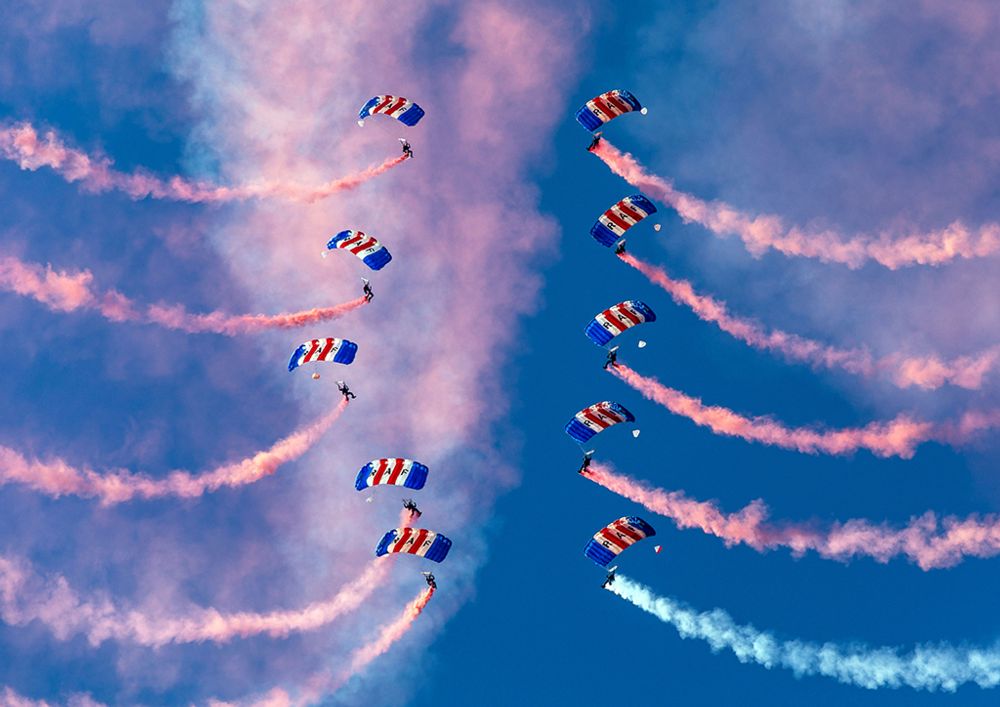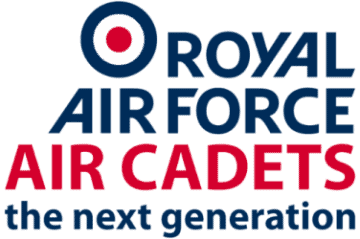2022 Events
Royal Air Force Falcons Display Venues 2022. Please note that all RAF Falcons display venue appearances are subject to weather conditions.
Display Parachuting
Display parachuting is one of the most difficult types of parachuting and requires hard work, a high level of skill and, most importantly, trust in other team members and their equipment. This is why the RAF Falcons are Britain's premier Parachute Display Team.

The RAF Falcons parachute display is both unique and flexible. This is necessary due to weather conditions that will dictate which of the three types of show the team may be asked to perform at very late notice.
Each display consists of the following:
- A variety of movements across the sky in freefall using coloured smokes to illustrate an aerial pattern.
- Demonstration of close proximity flying under canopy which includes The Heart, Criss-Cross Carousel, Snakes and Ducks and The Sabre Chase.
- Controlled and accurate landings into small confined areas, often near buildings or water. You can now see The Team land individually using our traditional Falcons landing pattern, or simultaneously landing in ‘ducks’.
Preparation
Approximately 2 hours before display, a detailed brief is given by the Team Coach on the type of display the Team are going to undertake.
Many factors are taken into consideration such as the weather, wind direction and hazards on the drop zone. The weather plays an important factor as this can determine which one of the shows will take place.
The Team will then perform whole demonstration on the ground from exit, freefall and canopy control to the landing pattern; a mental rehearsal of the whole display known as the 'Dirt Dive'.
The Exit
Ten minutes before the jump, either the ramp (Skyvan/C-130) or the door of the Dornier 228 is opened so the Team Coach can visually locate the drop zone, orientate himself and calculate the release point of the Team.
Two minutes before exit, the Team will practice their emergency drills in the unlikely event that they encounter any problems. The team then position themselves strategically for a faster and more efficient exit and await the light signals from the aircraft Captain. Red On, Green On, Go...
Freefall
Once the parachutists leave the aircraft they immediately begin the freefall phase of the display and within seconds they reach 'terminal velocity' - that's 120 mph, straight down!
Simply by altering their body position against the airflow, they can move around the sky with precision, enabling them to maintain the correct and safe distance away from the parachutist free-falling in front of them.
Dependent on what ‘show’ is being performed, this will change the height at which the Team Coach will deploy his parachute. All other parachutists are then responsible to time their deployment to match the height of the Team Coach, allowing everyone to be under their canopy at the same altitude.
Each member is responsible for deploying their own parachute by throwing a small drogue parachute into the air stream and this, in turn, pulls their main parachute out of its container.
Final Approach and Landing
The approach into a small landing area is difficult enough for one parachutist so with the addition of 9 others, all trying to land in quick succession, this proves to be the most challenging part of the display.
In order not to compromise safety, the parachutists stay roughly 15ft back and 15ft up from the parachutist below them, until it is their turn to commence their landing pattern, with odd numbers going straight on and even numbers peeling off 180 degrees before conducting their individual approaches and landing 1 after another in quick succession. If the Team are landing in a ‘ducks’ formation, all canopies will be on the same level as each other, flying one behind another approximately 15ft apart, waiting on the call from the Team Coach to perform a 90 degree left or right turn onto their into-wind leg so all parachutists are side-by-side enabling everyone to land at the same time. The RAF Falcons are renowned for their ability to land in confined spaces under immense pressure.
The Salute
Once all the team members are down safely they will then work quickly to take off all their ancillary equipment and put on their berets.
Then Drop Zone Safety Officer will call for the RAF Falcons to form up.
Once the team has formed up, the Drop Zone Safety Officer will march out to the front, salute, and then present the RAF Falcons to dignitaries and spectators.
Display Format
The Hybrid: From an altitude above 7,000ft the RAF Falcons will leave the Aircraft, free-falling down to 5,000ft before deploying their Parachutes. Once open, the team will form the Snake, before turning 180 degrees to the left.
After heading back to the drop-zone and assessing the teams position above the ground the Coach will call for the Heart. Once complete, and back in the Snake, odds will turn 180 degrees to the left, evens will turn right.
Here the team will prepare for the now famous ‘Criss-cross into Carousel’. During the ‘Criss-cross’ Parachutists will close in to each other at approximately 45mph. After crossing each other, a right turn will be conducted, which allows for the carousel to be formed.
Snakes and Ducks: Team Turns/Snakes and Ducks – In either formation (single line, loose patrol) the call from the Team Coach will be to initiate a left or right turn in unison to form “ducks” where each Falcon will fly side by side and “snakes” to reform the single line/loose patrol formation. This manoeuvre is used to position the patrol for other elements of the display. In a first for 2022, on larger drop zones the team are able to land in ducks.
The Heart: Formed whilst flying in ‘Snakes’, on the command of the Coach, odds and evens will split, turning 180 degrees in opposing directions. At this point, each team member will look across to their opposite numbers, assessing their relative position and flying the Parachute to ensure they slot in to their correct slot, back into ‘Snakes’.
The Low Show: Occasionally, when the weather dictates, the RAF Falcons will bring the drop height down to a minimum of 2500ft. Given the lower altitude, the team are afforded less time under canopy, thus having to tailor the display accordingly. During the ‘Low show’, the team form the Snake behind the Team Coach, who then leads the team directly into a Carousel, turning to the right. The team will remain in the Carousel until the coach exits leading the team into the landing pattern.
Display Day
The life of an RAF Falcon on a display day:
Parachutist Brief
The Team Coach gives a detailed brief to all other team members covering weather conditions, Drop Zone hazards and the type of display that will be conducted.
Dirt Dive
All team members practice on the ground exactly what is expected of them in the air.
Fitting of Equipment
The Team now will start ‘fitting up’ with the parachute system and all their ancillary equipment. Once complete another member of the Team will then go through a rigorous check process to ensure everything is fitted correctly and functioning properly.
Onboard
Once the Team take off, they start preparing for the display; this includes the fitting of smoke brackets and checking each other ensuring all parachute equipment that is required is worn and fitted correctly.
Spotting
When the aircraft is approximately 2 minutes from the Drop Zone the Team Coach will request directional control of the aircraft to ensure the Team exit at exactly the correct position.
Exit and Freefall
Depending on the type of aircraft, the Team either begin their display from the ramp or side doors.
At 30 seconds, no.2 will trail smoke out of the aircraft by hanging their leg out of the door. On the Coach’s command he will exit, followed by the remaining parachutists exiting 3 secs after one another, before pulling their parachutes on an even level, giving themselves the best opportunity to build in the snake formation.
Hybrid Show
Once under canopy, each team member positions themselves 10-15ft behind the parachutist in front of them, on the same level. Listening out for the coaches commands, everyone will perform the necessary manoeuvres to create the different aspects of the show.
Landing
The Team will aim to land on the 2 crosses placed on the Drop Zone. The Drop Zone can be as small as 75 x 75 yards although the team members are skilled enough to land in a much more confined area.
Line Up
As soon as the Falcons land they divest themselves of their equipment and run to the line up. As the Team Leader takes the salute, the display aircraft does its flypast with impeccable timing.
Public Relations
Public relations are really importance to the Team and, after each display, they look forward meeting members of the public, signing autographs and answering any questions they might have. All members of the Falcons appreciate the support they receive from the crowds and enjoy spending time after the display mingling.
Request a Display 2024
The RAF will not routinely conduct flypasts at corporate events or at private events such as weddings, birthdays or funerals etc.
The application deadline for 2024 flypast and display requests has now passed.
Applications for the 2025 display season will be available on this site by the end of June 2024. The deadlines for 2025 requests will be as follows:
Display Applications: 30 September 2024
Flypast Applications: 30 November 2024
Flying displays can only be conducted at recognised display venues under the supervision of a CAA-accredited flying display director.
All correspondence to the RAF Air Events Team should be submitted electronically to [email protected]. We are no longer accepting applications via post.







